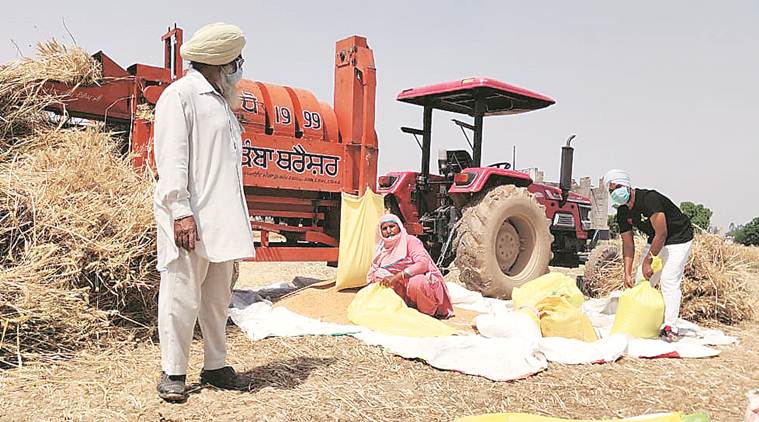 Jagjit Singh (right) helps his parents harvest the family’s wheat crop in Ban Majra village. (Express Photo)
Jagjit Singh (right) helps his parents harvest the family’s wheat crop in Ban Majra village. (Express Photo)
Coronavirus (COVID-19): AN MBBS final-year student, Jagjit Singh should have been preparing for his exams at Thanjavur Medical College, Tamil Nadu. Instead, with the exams postponed, the 23-year-old is helping his parents harvest the family’s wheat crop in Ropar’s Ban Majra village.
As wheat harvesting began in Punjab on Wednesday, of an estimated 135 lakh metric tonnes of produce worth Rs 26,000 crore, families like Jagjit’s are pooling in hands to finish the task amid scarce labour and rising coronavirus cases. The state’s tally is nearing 200, with 13 deaths.
The guidelines regarding the second phase of the lockdown, released by the Centre on Wednesday, have rural economy as a thrust area, allowing all agricultural and allied activities. A Home Ministry official said implicit in these guidelines was free movement of labour in rural areas, for agricultural as well as industrial activity.
Punjab’s Additional Chief Secretary, Agriculture, Horticulture and Food Processing, Viswajeet Khanna said, “Due to the lockdown, we have been short of labour in the wheat procurement season as most of them come from other states. Allowing free movement of labour will be good for us, we would be able to mobilise local labour and the MNREGS for harvesting of wheat. We will ensure that social distancing norms are adhered to.”
Wearing a mask like son Jagjit and wife Leela Devi as they carry harvested wheat from their field home, Hazara Singh, 74, says he has rented a thresher from Kulwant Singh in adjoining Bhagowala village, in exchange for “12 peepe (containers)” of wheat. Each iron container holds 15 kg of wheat.
Jagjit arrived home in March, just days ahead of the national lockdown. “We have advanced harvesting by a week to finish the job at the earliest. With increasing number of coronavirus cases, delayed harvesting could have meant cases among labour as well, bringing infection to the village,” he says, as he keeps instructing farm hands to cover their faces with whatever cloth they have.
The family has engaged around half-a-dozen people from the village to harvest their two bighas. Before COVID-19 brought work to a halt, some of them had been employed as daily wagers.
Kulwant, who has lent the thresher, owns 5 acres on which he has grown wheat. “I have engaged eight labourers. Some of them worked in nearby factories,” he says, adding that he would give the eight 2.5 quintals of wheat per acre as payment.
Kulwant says he prefers manual labour to combine harvesters as this leaves him fodder for his cattle. While his usual yield is 20 quintals per acre, he expects a decline due to hailstorm and rain last month.
In adjoining Mohali district, Rajinder Singh of Barodi village has hired road construction labourers from UP for his one-acre farm, who are at work with their faces covered. “They have been living in the village and were without any work. It suited both me and them,” Rajinder says.
In Pallanpur village, Mohan Lal, 60, says he is doing harvesting work for the first time. Along with him, his twin sons Mohinder and Bablu and daughter Sonia have been employed by a village farmer. “I have been working in a brick kiln all my life. I was left with no job due to the lockdown. It is good I got this work,” says Mohan Lal.
Son Mohinder doesn’t expect the relaxation allowing brick kilns in rural areas to help them. “The brick kiln season will end in June. After that, the rains will start and work will resume only in January next year.”
Moga Deputy Commissioner Sandeep Hans said the order to allow food processing industry might not mean much of a change for them either. Moga houses a factory of Nestle. Pointing out that food processing industry was counted among essential services earlier too, Hans said, “Among the products made by Nestle here is powdered milk. From day one, Nestle has been allowed to operate.”
Don’t miss these articles on Coronavirus from the Explained section:
‣ How coronavirus attacks, step by step
‣ Mask or no mask? Why the guidance has been shifting
‣ Besides a face cover, should I wear gloves when I go outdoors?
‣ How the Agra, Bhilwara and Pathanamthitta Covid-19 containment models differ